steering BMW M6 COUPE 2014 F13M Service Manual
[x] Cancel search | Manufacturer: BMW, Model Year: 2014, Model line: M6 COUPE, Model: BMW M6 COUPE 2014 F13MPages: 222, PDF Size: 4.8 MB
Page 162 of 222
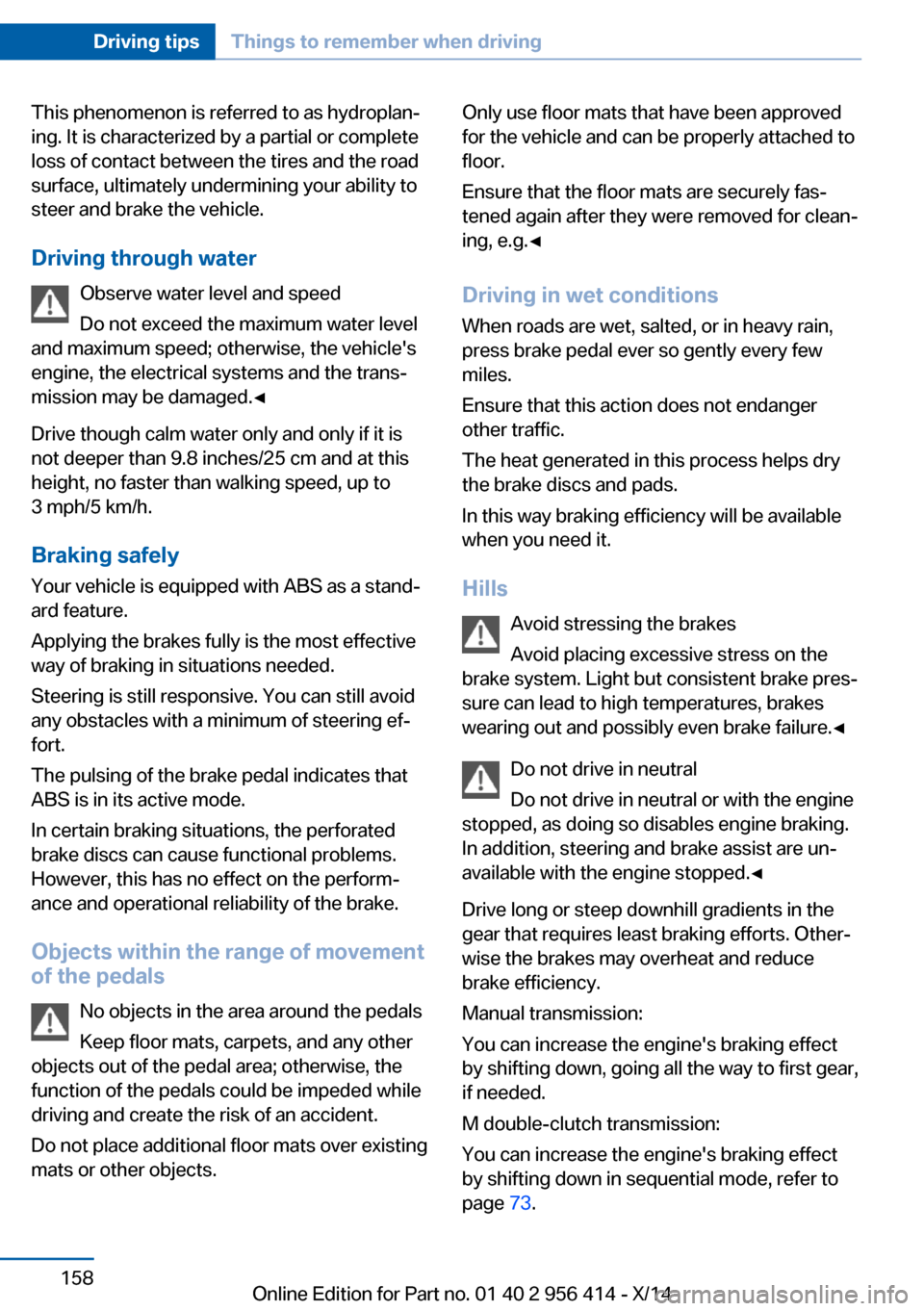
This phenomenon is referred to as hydroplan‐
ing. It is characterized by a partial or complete
loss of contact between the tires and the road
surface, ultimately undermining your ability to
steer and brake the vehicle.
Driving through water Observe water level and speed
Do not exceed the maximum water level
and maximum speed; otherwise, the vehicle's
engine, the electrical systems and the trans‐
mission may be damaged.◀
Drive though calm water only and only if it is
not deeper than 9.8 inches/25 cm and at this
height, no faster than walking speed, up to
3 mph/5 km/h.
Braking safely
Your vehicle is equipped with ABS as a stand‐
ard feature.
Applying the brakes fully is the most effective
way of braking in situations needed.
Steering is still responsive. You can still avoid
any obstacles with a minimum of steering ef‐
fort.
The pulsing of the brake pedal indicates that
ABS is in its active mode.
In certain braking situations, the perforated
brake discs can cause functional problems.
However, this has no effect on the perform‐
ance and operational reliability of the brake.
Objects within the range of movement
of the pedals
No objects in the area around the pedals
Keep floor mats, carpets, and any other
objects out of the pedal area; otherwise, the
function of the pedals could be impeded while driving and create the risk of an accident.
Do not place additional floor mats over existing
mats or other objects.Only use floor mats that have been approved
for the vehicle and can be properly attached to
floor.
Ensure that the floor mats are securely fas‐
tened again after they were removed for clean‐
ing, e.g.◀
Driving in wet conditions When roads are wet, salted, or in heavy rain,
press brake pedal ever so gently every few
miles.
Ensure that this action does not endanger other traffic.
The heat generated in this process helps dry
the brake discs and pads.
In this way braking efficiency will be available
when you need it.
Hills Avoid stressing the brakes
Avoid placing excessive stress on the
brake system. Light but consistent brake pres‐
sure can lead to high temperatures, brakes
wearing out and possibly even brake failure.◀
Do not drive in neutral
Do not drive in neutral or with the engine
stopped, as doing so disables engine braking.
In addition, steering and brake assist are un‐
available with the engine stopped.◀
Drive long or steep downhill gradients in the
gear that requires least braking efforts. Other‐
wise the brakes may overheat and reduce
brake efficiency.
Manual transmission:
You can increase the engine's braking effect
by shifting down, going all the way to first gear,
if needed.
M double-clutch transmission:
You can increase the engine's braking effect
by shifting down in sequential mode, refer to
page 73.Seite 158Driving tipsThings to remember when driving158
Online Edition for Part no. 01 40 2 956 414 - X/14
Page 179 of 222
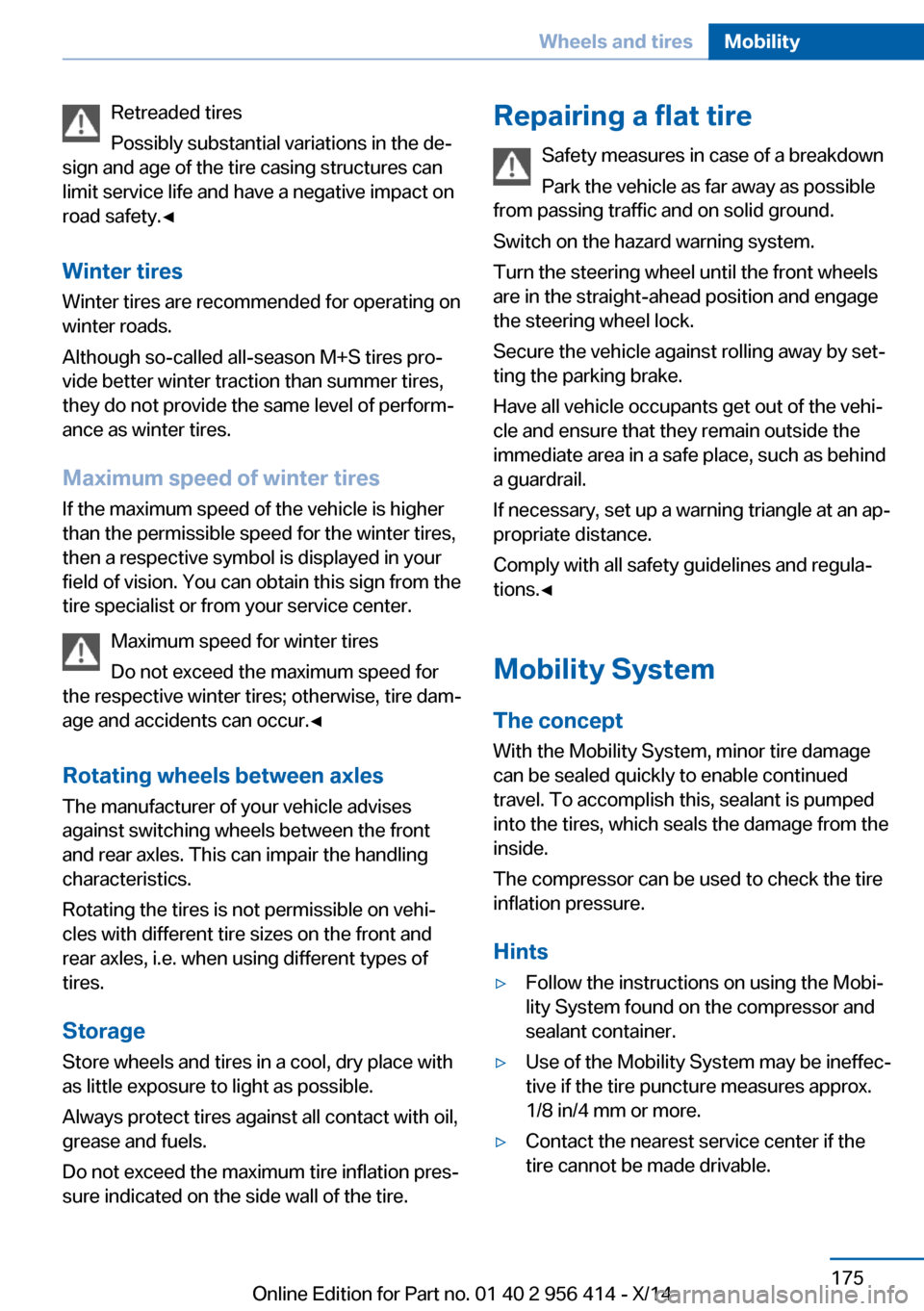
Retreaded tires
Possibly substantial variations in the de‐
sign and age of the tire casing structures can
limit service life and have a negative impact on
road safety.◀
Winter tires
Winter tires are recommended for operating on
winter roads.
Although so-called all-season M+S tires pro‐
vide better winter traction than summer tires, they do not provide the same level of perform‐
ance as winter tires.
Maximum speed of winter tires If the maximum speed of the vehicle is higher
than the permissible speed for the winter tires,
then a respective symbol is displayed in your
field of vision. You can obtain this sign from the
tire specialist or from your service center.
Maximum speed for winter tires
Do not exceed the maximum speed for
the respective winter tires; otherwise, tire dam‐
age and accidents can occur.◀
Rotating wheels between axles The manufacturer of your vehicle advises
against switching wheels between the front
and rear axles. This can impair the handling
characteristics.
Rotating the tires is not permissible on vehi‐
cles with different tire sizes on the front and
rear axles, i.e. when using different types of
tires.
Storage Store wheels and tires in a cool, dry place with
as little exposure to light as possible.
Always protect tires against all contact with oil,
grease and fuels.
Do not exceed the maximum tire inflation pres‐
sure indicated on the side wall of the tire.Repairing a flat tire
Safety measures in case of a breakdown
Park the vehicle as far away as possible
from passing traffic and on solid ground.
Switch on the hazard warning system.
Turn the steering wheel until the front wheels are in the straight-ahead position and engage
the steering wheel lock.
Secure the vehicle against rolling away by set‐
ting the parking brake.
Have all vehicle occupants get out of the vehi‐
cle and ensure that they remain outside the
immediate area in a safe place, such as behind
a guardrail.
If necessary, set up a warning triangle at an ap‐
propriate distance.
Comply with all safety guidelines and regula‐
tions.◀
Mobility System
The concept With the Mobility System, minor tire damage
can be sealed quickly to enable continued
travel. To accomplish this, sealant is pumped
into the tires, which seals the damage from the
inside.
The compressor can be used to check the tire
inflation pressure.
Hints▷Follow the instructions on using the Mobi‐
lity System found on the compressor and
sealant container.▷Use of the Mobility System may be ineffec‐
tive if the tire puncture measures approx.
1/8 in/4 mm or more.▷Contact the nearest service center if the
tire cannot be made drivable.Seite 175Wheels and tiresMobility175
Online Edition for Part no. 01 40 2 956 414 - X/14
Page 180 of 222
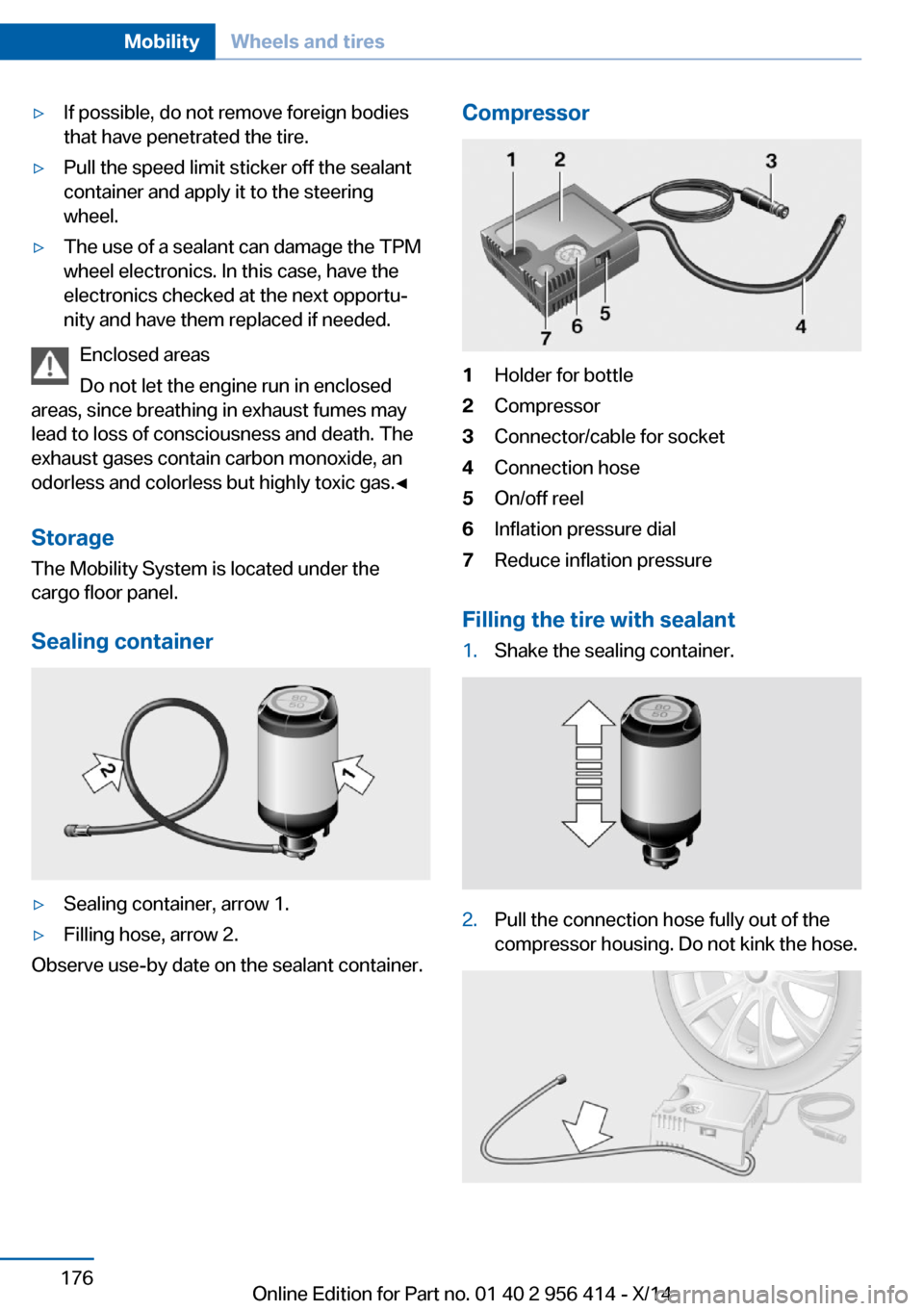
▷If possible, do not remove foreign bodies
that have penetrated the tire.▷Pull the speed limit sticker off the sealant
container and apply it to the steering
wheel.▷The use of a sealant can damage the TPM
wheel electronics. In this case, have the
electronics checked at the next opportu‐
nity and have them replaced if needed.
Enclosed areas
Do not let the engine run in enclosed
areas, since breathing in exhaust fumes may
lead to loss of consciousness and death. The
exhaust gases contain carbon monoxide, an
odorless and colorless but highly toxic gas.◀
Storage The Mobility System is located under the
cargo floor panel.
Sealing container
▷Sealing container, arrow 1.▷Filling hose, arrow 2.
Observe use-by date on the sealant container.
Compressor1Holder for bottle2Compressor3Connector/cable for socket4Connection hose5On/off reel6Inflation pressure dial7Reduce inflation pressure
Filling the tire with sealant
1.Shake the sealing container.2.Pull the connection hose fully out of the
compressor housing. Do not kink the hose.Seite 176MobilityWheels and tires176
Online Edition for Part no. 01 40 2 956 414 - X/14
Page 195 of 222
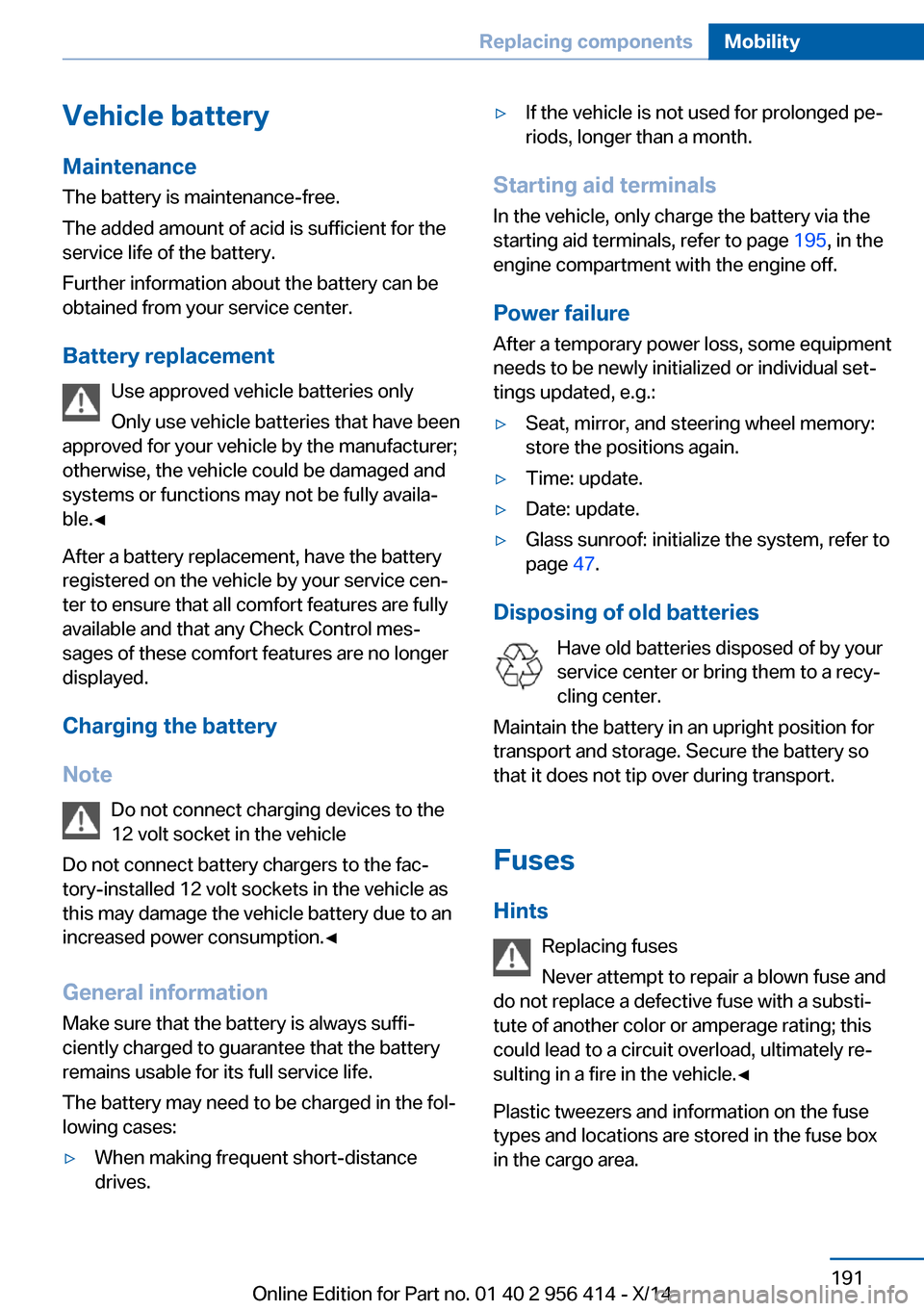
Vehicle batteryMaintenance
The battery is maintenance-free.
The added amount of acid is sufficient for the
service life of the battery.
Further information about the battery can be
obtained from your service center.
Battery replacement Use approved vehicle batteries only
Only use vehicle batteries that have been
approved for your vehicle by the manufacturer;
otherwise, the vehicle could be damaged and
systems or functions may not be fully availa‐
ble.◀
After a battery replacement, have the battery
registered on the vehicle by your service cen‐
ter to ensure that all comfort features are fully
available and that any Check Control mes‐
sages of these comfort features are no longer
displayed.
Charging the battery
Note Do not connect charging devices to the12 volt socket in the vehicle
Do not connect battery chargers to the fac‐
tory-installed 12 volt sockets in the vehicle as
this may damage the vehicle battery due to an
increased power consumption.◀
General information Make sure that the battery is always suffi‐
ciently charged to guarantee that the battery
remains usable for its full service life.
The battery may need to be charged in the fol‐
lowing cases:▷When making frequent short-distance
drives.▷If the vehicle is not used for prolonged pe‐
riods, longer than a month.
Starting aid terminals
In the vehicle, only charge the battery via the
starting aid terminals, refer to page 195, in the
engine compartment with the engine off.
Power failure After a temporary power loss, some equipment
needs to be newly initialized or individual set‐
tings updated, e.g.:
▷Seat, mirror, and steering wheel memory:
store the positions again.▷Time: update.▷Date: update.▷Glass sunroof: initialize the system, refer to
page 47.
Disposing of old batteries
Have old batteries disposed of by your
service center or bring them to a recy‐
cling center.
Maintain the battery in an upright position for
transport and storage. Secure the battery so
that it does not tip over during transport.
Fuses Hints Replacing fuses
Never attempt to repair a blown fuse and
do not replace a defective fuse with a substi‐
tute of another color or amperage rating; this
could lead to a circuit overload, ultimately re‐
sulting in a fire in the vehicle.◀
Plastic tweezers and information on the fuse
types and locations are stored in the fuse box
in the cargo area.
Seite 191Replacing componentsMobility191
Online Edition for Part no. 01 40 2 956 414 - X/14
Page 200 of 222
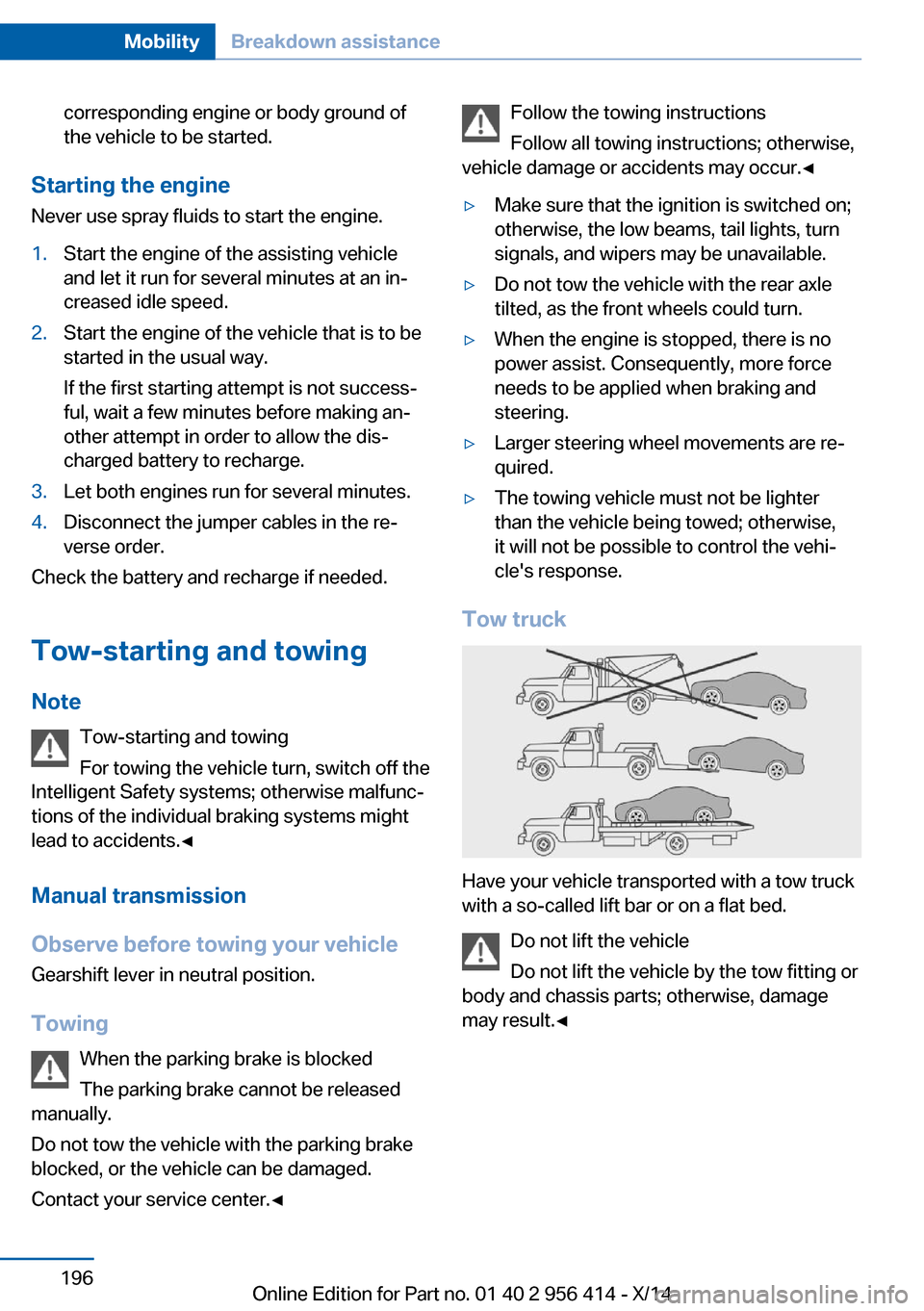
corresponding engine or body ground of
the vehicle to be started.
Starting the engine
Never use spray fluids to start the engine.
1.Start the engine of the assisting vehicle
and let it run for several minutes at an in‐
creased idle speed.2.Start the engine of the vehicle that is to be
started in the usual way.
If the first starting attempt is not success‐
ful, wait a few minutes before making an‐
other attempt in order to allow the dis‐
charged battery to recharge.3.Let both engines run for several minutes.4.Disconnect the jumper cables in the re‐
verse order.
Check the battery and recharge if needed.
Tow-starting and towing Note Tow-starting and towing
For towing the vehicle turn, switch off the
Intelligent Safety systems; otherwise malfunc‐
tions of the individual braking systems might
lead to accidents.◀
Manual transmission
Observe before towing your vehicle Gearshift lever in neutral position.
Towing When the parking brake is blocked
The parking brake cannot be released
manually.
Do not tow the vehicle with the parking brake
blocked, or the vehicle can be damaged.
Contact your service center.◀
Follow the towing instructions
Follow all towing instructions; otherwise,
vehicle damage or accidents may occur.◀▷Make sure that the ignition is switched on;
otherwise, the low beams, tail lights, turn
signals, and wipers may be unavailable.▷Do not tow the vehicle with the rear axle
tilted, as the front wheels could turn.▷When the engine is stopped, there is no
power assist. Consequently, more force
needs to be applied when braking and
steering.▷Larger steering wheel movements are re‐
quired.▷The towing vehicle must not be lighter
than the vehicle being towed; otherwise,
it will not be possible to control the vehi‐
cle's response.
Tow truck
Have your vehicle transported with a tow truck
with a so-called lift bar or on a flat bed.
Do not lift the vehicle
Do not lift the vehicle by the tow fitting or
body and chassis parts; otherwise, damage
may result.◀
Seite 196MobilityBreakdown assistance196
Online Edition for Part no. 01 40 2 956 414 - X/14
Page 212 of 222
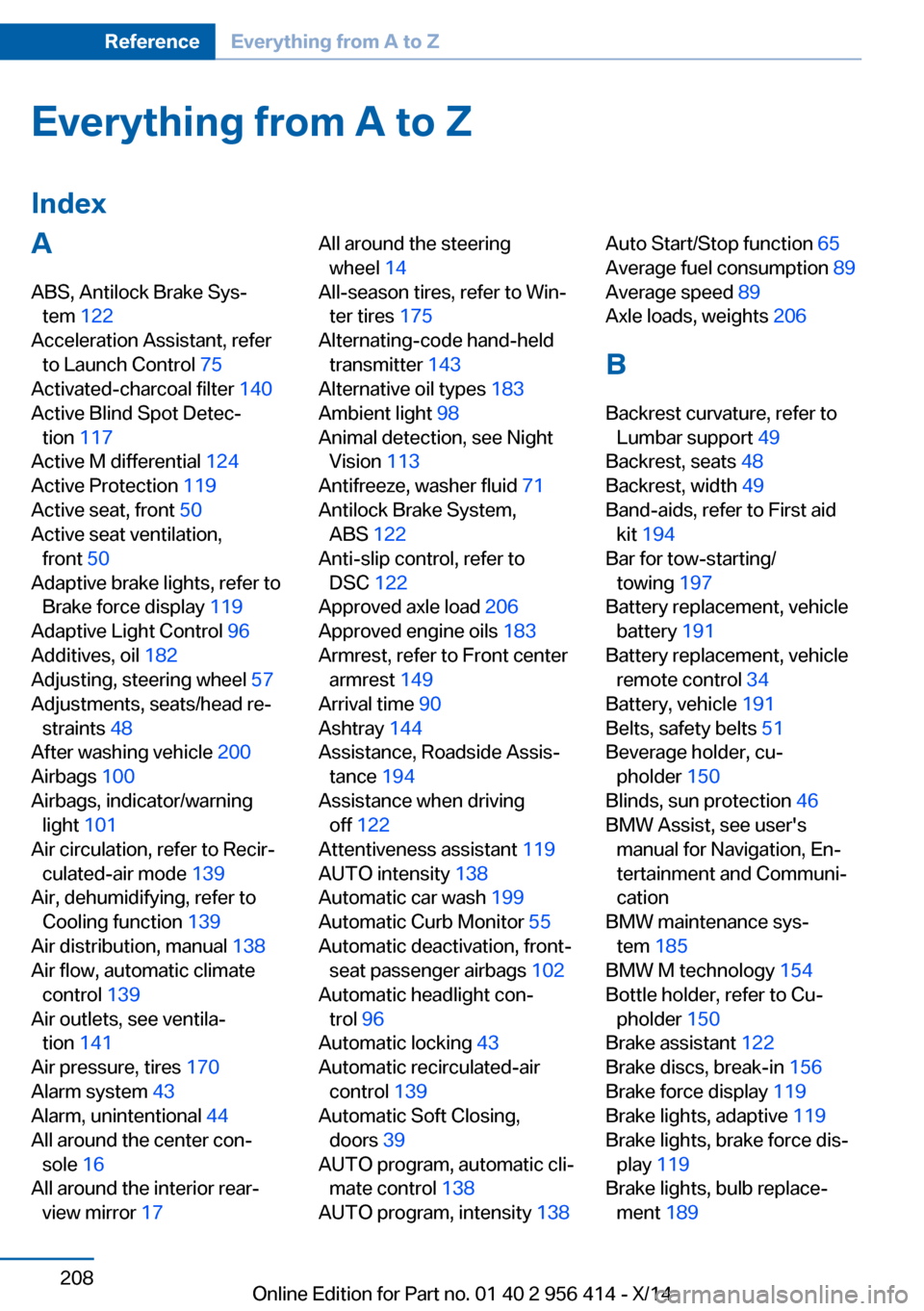
Everything from A to Z
IndexA ABS, Antilock Brake Sys‐ tem 122
Acceleration Assistant, refer to Launch Control 75
Activated-charcoal filter 140
Active Blind Spot Detec‐ tion 117
Active M differential 124
Active Protection 119
Active seat, front 50
Active seat ventilation, front 50
Adaptive brake lights, refer to Brake force display 119
Adaptive Light Control 96
Additives, oil 182
Adjusting, steering wheel 57
Adjustments, seats/head re‐ straints 48
After washing vehicle 200
Airbags 100
Airbags, indicator/warning light 101
Air circulation, refer to Recir‐ culated-air mode 139
Air, dehumidifying, refer to Cooling function 139
Air distribution, manual 138
Air flow, automatic climate control 139
Air outlets, see ventila‐ tion 141
Air pressure, tires 170
Alarm system 43
Alarm, unintentional 44
All around the center con‐ sole 16
All around the interior rear‐ view mirror 17 All around the steering
wheel 14
All-season tires, refer to Win‐ ter tires 175
Alternating-code hand-held transmitter 143
Alternative oil types 183
Ambient light 98
Animal detection, see Night Vision 113
Antifreeze, washer fluid 71
Antilock Brake System, ABS 122
Anti-slip control, refer to DSC 122
Approved axle load 206
Approved engine oils 183
Armrest, refer to Front center armrest 149
Arrival time 90
Ashtray 144
Assistance, Roadside Assis‐ tance 194
Assistance when driving off 122
Attentiveness assistant 119
AUTO intensity 138
Automatic car wash 199
Automatic Curb Monitor 55
Automatic deactivation, front- seat passenger airbags 102
Automatic headlight con‐ trol 96
Automatic locking 43
Automatic recirculated-air control 139
Automatic Soft Closing, doors 39
AUTO program, automatic cli‐ mate control 138
AUTO program, intensity 138 Auto Start/Stop function 65
Average fuel consumption 89
Average speed 89
Axle loads, weights 206
B Backrest curvature, refer to Lumbar support 49
Backrest, seats 48
Backrest, width 49
Band-aids, refer to First aid kit 194
Bar for tow-starting/ towing 197
Battery replacement, vehicle battery 191
Battery replacement, vehicle remote control 34
Battery, vehicle 191
Belts, safety belts 51
Beverage holder, cu‐ pholder 150
Blinds, sun protection 46
BMW Assist, see user's manual for Navigation, En‐
tertainment and Communi‐
cation
BMW maintenance sys‐ tem 185
BMW M technology 154
Bottle holder, refer to Cu‐ pholder 150
Brake assistant 122
Brake discs, break-in 156
Brake force display 119
Brake lights, adaptive 119
Brake lights, brake force dis‐ play 119
Brake lights, bulb replace‐ ment 189 Seite 208ReferenceEverything from A to Z208
Online Edition for Part no. 01 40 2 956 414 - X/14
Page 213 of 222
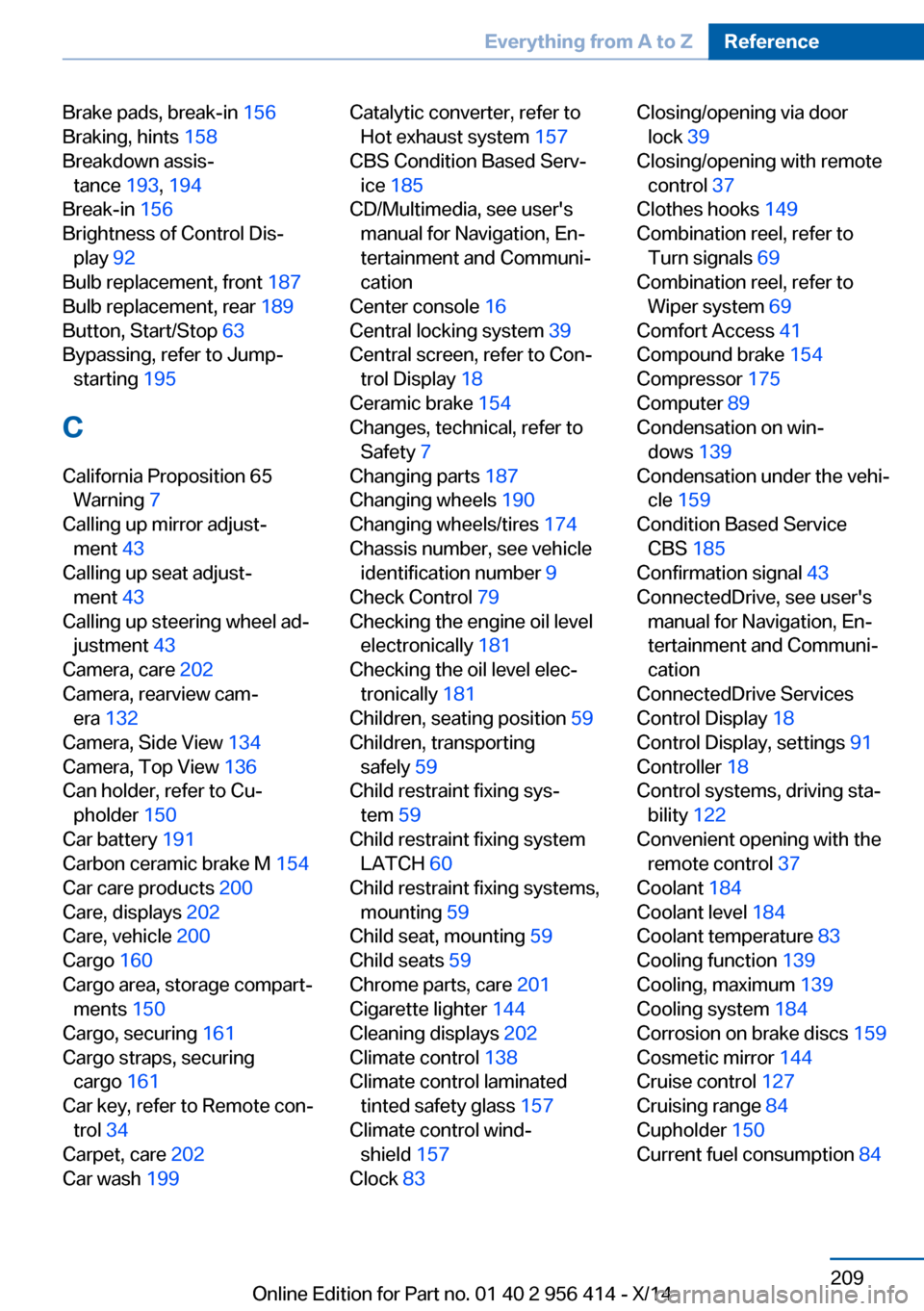
Brake pads, break-in 156
Braking, hints 158
Breakdown assis‐ tance 193, 194
Break-in 156
Brightness of Control Dis‐ play 92
Bulb replacement, front 187
Bulb replacement, rear 189
Button, Start/Stop 63
Bypassing, refer to Jump- starting 195
C
California Proposition 65 Warning 7
Calling up mirror adjust‐ ment 43
Calling up seat adjust‐ ment 43
Calling up steering wheel ad‐ justment 43
Camera, care 202
Camera, rearview cam‐ era 132
Camera, Side View 134
Camera, Top View 136
Can holder, refer to Cu‐ pholder 150
Car battery 191
Carbon ceramic brake M 154
Car care products 200
Care, displays 202
Care, vehicle 200
Cargo 160
Cargo area, storage compart‐ ments 150
Cargo, securing 161
Cargo straps, securing cargo 161
Car key, refer to Remote con‐ trol 34
Carpet, care 202
Car wash 199 Catalytic converter, refer to
Hot exhaust system 157
CBS Condition Based Serv‐ ice 185
CD/Multimedia, see user's manual for Navigation, En‐
tertainment and Communi‐
cation
Center console 16
Central locking system 39
Central screen, refer to Con‐ trol Display 18
Ceramic brake 154
Changes, technical, refer to Safety 7
Changing parts 187
Changing wheels 190
Changing wheels/tires 174
Chassis number, see vehicle identification number 9
Check Control 79
Checking the engine oil level electronically 181
Checking the oil level elec‐ tronically 181
Children, seating position 59
Children, transporting safely 59
Child restraint fixing sys‐ tem 59
Child restraint fixing system LATCH 60
Child restraint fixing systems, mounting 59
Child seat, mounting 59
Child seats 59
Chrome parts, care 201
Cigarette lighter 144
Cleaning displays 202
Climate control 138
Climate control laminated tinted safety glass 157
Climate control wind‐ shield 157
Clock 83 Closing/opening via door
lock 39
Closing/opening with remote control 37
Clothes hooks 149
Combination reel, refer to Turn signals 69
Combination reel, refer to Wiper system 69
Comfort Access 41
Compound brake 154
Compressor 175
Computer 89
Condensation on win‐ dows 139
Condensation under the vehi‐ cle 159
Condition Based Service CBS 185
Confirmation signal 43
ConnectedDrive, see user's manual for Navigation, En‐
tertainment and Communi‐
cation
ConnectedDrive Services
Control Display 18
Control Display, settings 91
Controller 18
Control systems, driving sta‐ bility 122
Convenient opening with the remote control 37
Coolant 184
Coolant level 184
Coolant temperature 83
Cooling function 139
Cooling, maximum 139
Cooling system 184
Corrosion on brake discs 159
Cosmetic mirror 144
Cruise control 127
Cruising range 84
Cupholder 150
Current fuel consumption 84 Seite 209Everything from A to ZReference209
Online Edition for Part no. 01 40 2 956 414 - X/14
Page 214 of 222
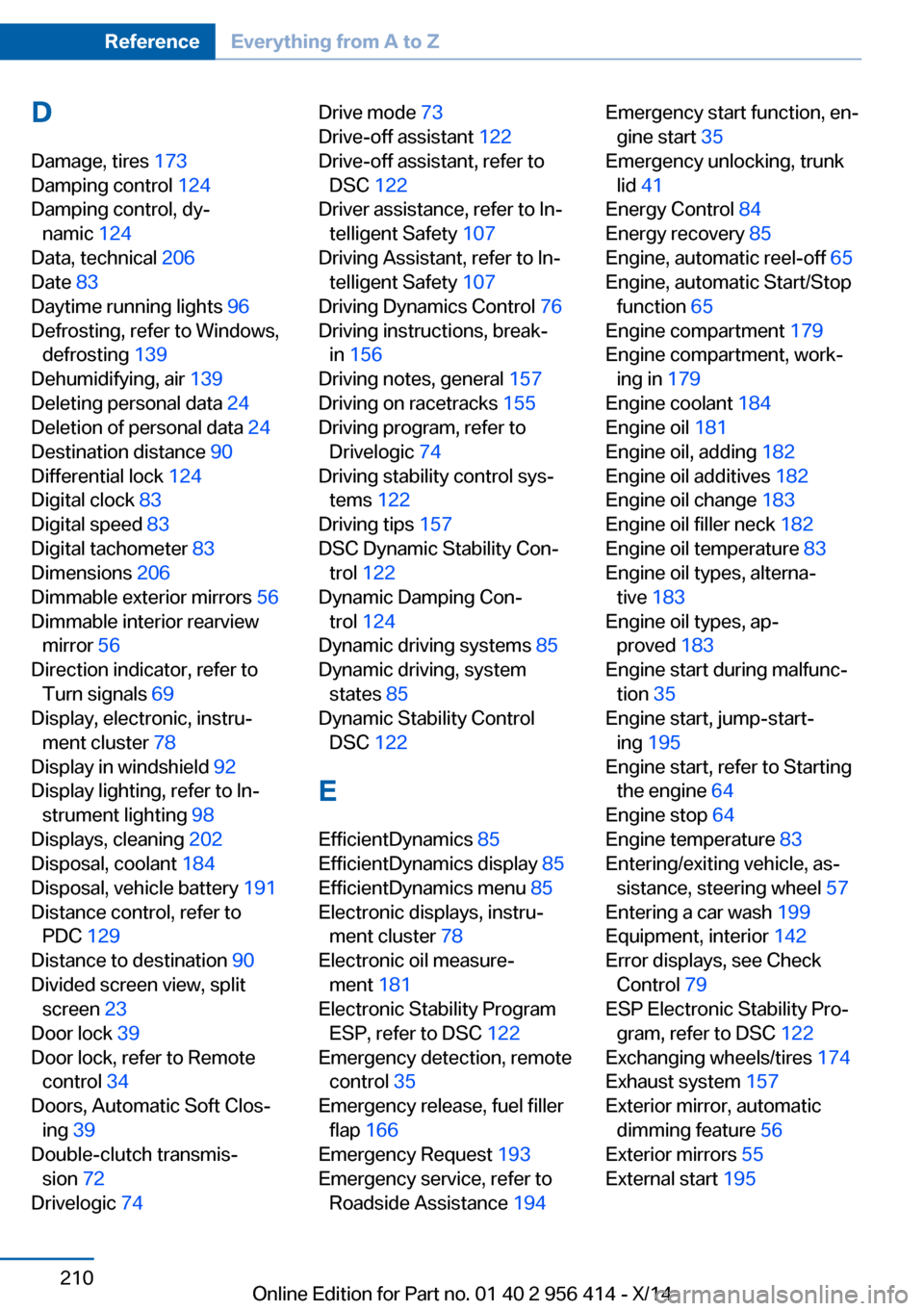
D
Damage, tires 173
Damping control 124
Damping control, dy‐ namic 124
Data, technical 206
Date 83
Daytime running lights 96
Defrosting, refer to Windows, defrosting 139
Dehumidifying, air 139
Deleting personal data 24
Deletion of personal data 24
Destination distance 90
Differential lock 124
Digital clock 83
Digital speed 83
Digital tachometer 83
Dimensions 206
Dimmable exterior mirrors 56
Dimmable interior rearview mirror 56
Direction indicator, refer to Turn signals 69
Display, electronic, instru‐ ment cluster 78
Display in windshield 92
Display lighting, refer to In‐ strument lighting 98
Displays, cleaning 202
Disposal, coolant 184
Disposal, vehicle battery 191
Distance control, refer to PDC 129
Distance to destination 90
Divided screen view, split screen 23
Door lock 39
Door lock, refer to Remote control 34
Doors, Automatic Soft Clos‐ ing 39
Double-clutch transmis‐ sion 72
Drivelogic 74 Drive mode 73
Drive-off assistant 122
Drive-off assistant, refer to DSC 122
Driver assistance, refer to In‐ telligent Safety 107
Driving Assistant, refer to In‐ telligent Safety 107
Driving Dynamics Control 76
Driving instructions, break- in 156
Driving notes, general 157
Driving on racetracks 155
Driving program, refer to Drivelogic 74
Driving stability control sys‐ tems 122
Driving tips 157
DSC Dynamic Stability Con‐ trol 122
Dynamic Damping Con‐ trol 124
Dynamic driving systems 85
Dynamic driving, system states 85
Dynamic Stability Control DSC 122
E
EfficientDynamics 85
EfficientDynamics display 85
EfficientDynamics menu 85
Electronic displays, instru‐ ment cluster 78
Electronic oil measure‐ ment 181
Electronic Stability Program ESP, refer to DSC 122
Emergency detection, remote control 35
Emergency release, fuel filler flap 166
Emergency Request 193
Emergency service, refer to Roadside Assistance 194 Emergency start function, en‐
gine start 35
Emergency unlocking, trunk lid 41
Energy Control 84
Energy recovery 85
Engine, automatic reel-off 65
Engine, automatic Start/Stop function 65
Engine compartment 179
Engine compartment, work‐ ing in 179
Engine coolant 184
Engine oil 181
Engine oil, adding 182
Engine oil additives 182
Engine oil change 183
Engine oil filler neck 182
Engine oil temperature 83
Engine oil types, alterna‐ tive 183
Engine oil types, ap‐ proved 183
Engine start during malfunc‐ tion 35
Engine start, jump-start‐ ing 195
Engine start, refer to Starting the engine 64
Engine stop 64
Engine temperature 83
Entering/exiting vehicle, as‐ sistance, steering wheel 57
Entering a car wash 199
Equipment, interior 142
Error displays, see Check Control 79
ESP Electronic Stability Pro‐ gram, refer to DSC 122
Exchanging wheels/tires 174
Exhaust system 157
Exterior mirror, automatic dimming feature 56
Exterior mirrors 55
External start 195 Seite 210ReferenceEverything from A to Z210
Online Edition for Part no. 01 40 2 956 414 - X/14
Page 217 of 222
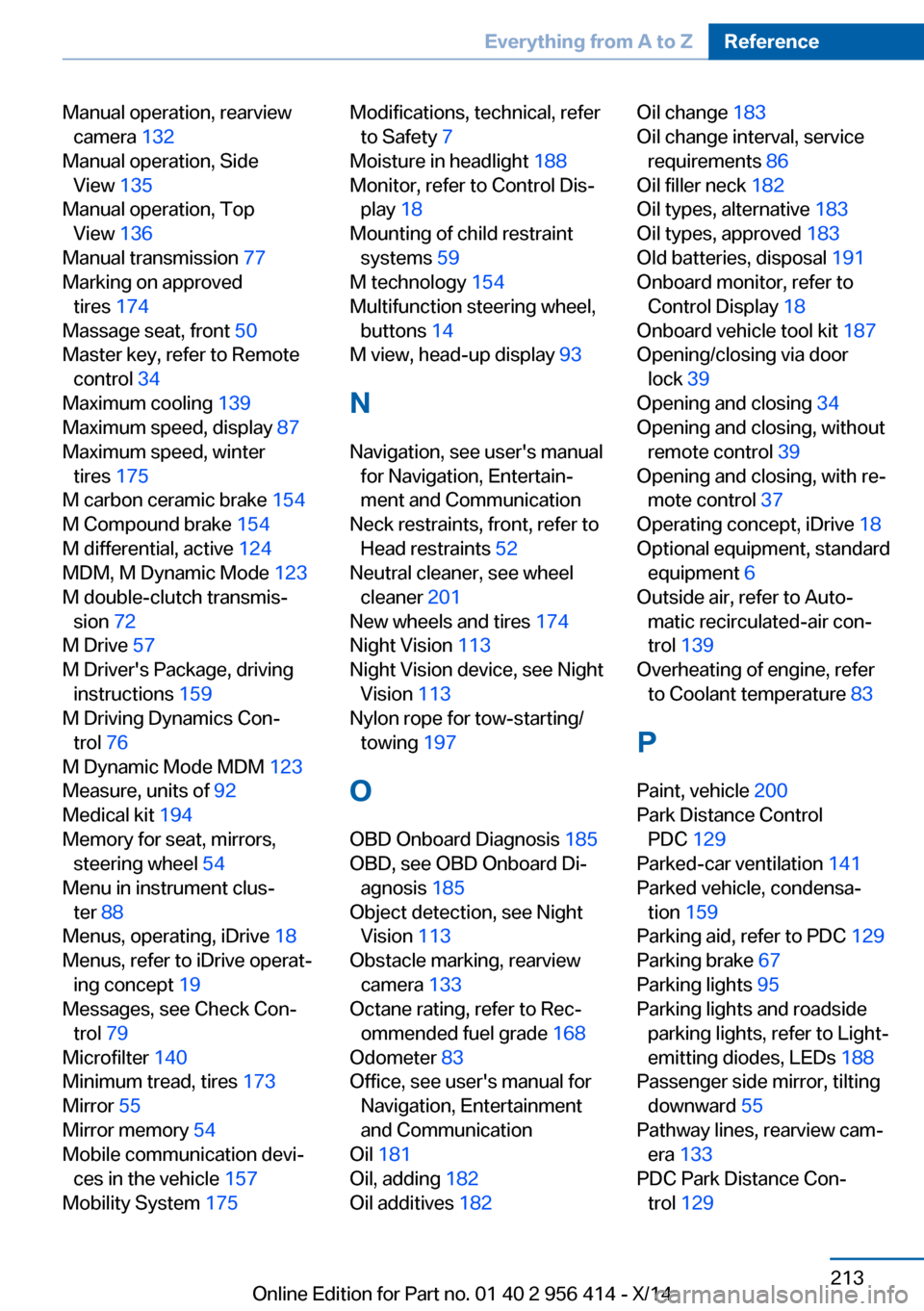
Manual operation, rearviewcamera 132
Manual operation, Side View 135
Manual operation, Top View 136
Manual transmission 77
Marking on approved tires 174
Massage seat, front 50
Master key, refer to Remote control 34
Maximum cooling 139
Maximum speed, display 87
Maximum speed, winter tires 175
M carbon ceramic brake 154
M Compound brake 154
M differential, active 124
MDM, M Dynamic Mode 123
M double-clutch transmis‐ sion 72
M Drive 57
M Driver's Package, driving instructions 159
M Driving Dynamics Con‐ trol 76
M Dynamic Mode MDM 123
Measure, units of 92
Medical kit 194
Memory for seat, mirrors, steering wheel 54
Menu in instrument clus‐ ter 88
Menus, operating, iDrive 18
Menus, refer to iDrive operat‐ ing concept 19
Messages, see Check Con‐ trol 79
Microfilter 140
Minimum tread, tires 173
Mirror 55
Mirror memory 54
Mobile communication devi‐ ces in the vehicle 157
Mobility System 175 Modifications, technical, refer
to Safety 7
Moisture in headlight 188
Monitor, refer to Control Dis‐ play 18
Mounting of child restraint systems 59
M technology 154
Multifunction steering wheel, buttons 14
M view, head-up display 93
N Navigation, see user's manual for Navigation, Entertain‐
ment and Communication
Neck restraints, front, refer to Head restraints 52
Neutral cleaner, see wheel cleaner 201
New wheels and tires 174
Night Vision 113
Night Vision device, see Night Vision 113
Nylon rope for tow-starting/ towing 197
O OBD Onboard Diagnosis 185
OBD, see OBD Onboard Di‐ agnosis 185
Object detection, see Night Vision 113
Obstacle marking, rearview camera 133
Octane rating, refer to Rec‐ ommended fuel grade 168
Odometer 83
Office, see user's manual for Navigation, Entertainment
and Communication
Oil 181
Oil, adding 182
Oil additives 182 Oil change 183
Oil change interval, service requirements 86
Oil filler neck 182
Oil types, alternative 183
Oil types, approved 183
Old batteries, disposal 191
Onboard monitor, refer to Control Display 18
Onboard vehicle tool kit 187
Opening/closing via door lock 39
Opening and closing 34
Opening and closing, without remote control 39
Opening and closing, with re‐ mote control 37
Operating concept, iDrive 18
Optional equipment, standard equipment 6
Outside air, refer to Auto‐ matic recirculated-air con‐
trol 139
Overheating of engine, refer to Coolant temperature 83
P Paint, vehicle 200
Park Distance Control PDC 129
Parked-car ventilation 141
Parked vehicle, condensa‐ tion 159
Parking aid, refer to PDC 129
Parking brake 67
Parking lights 95
Parking lights and roadside parking lights, refer to Light-
emitting diodes, LEDs 188
Passenger side mirror, tilting downward 55
Pathway lines, rearview cam‐ era 133
PDC Park Distance Con‐ trol 129 Seite 213Everything from A to ZReference213
Online Edition for Part no. 01 40 2 956 414 - X/14
Page 218 of 222
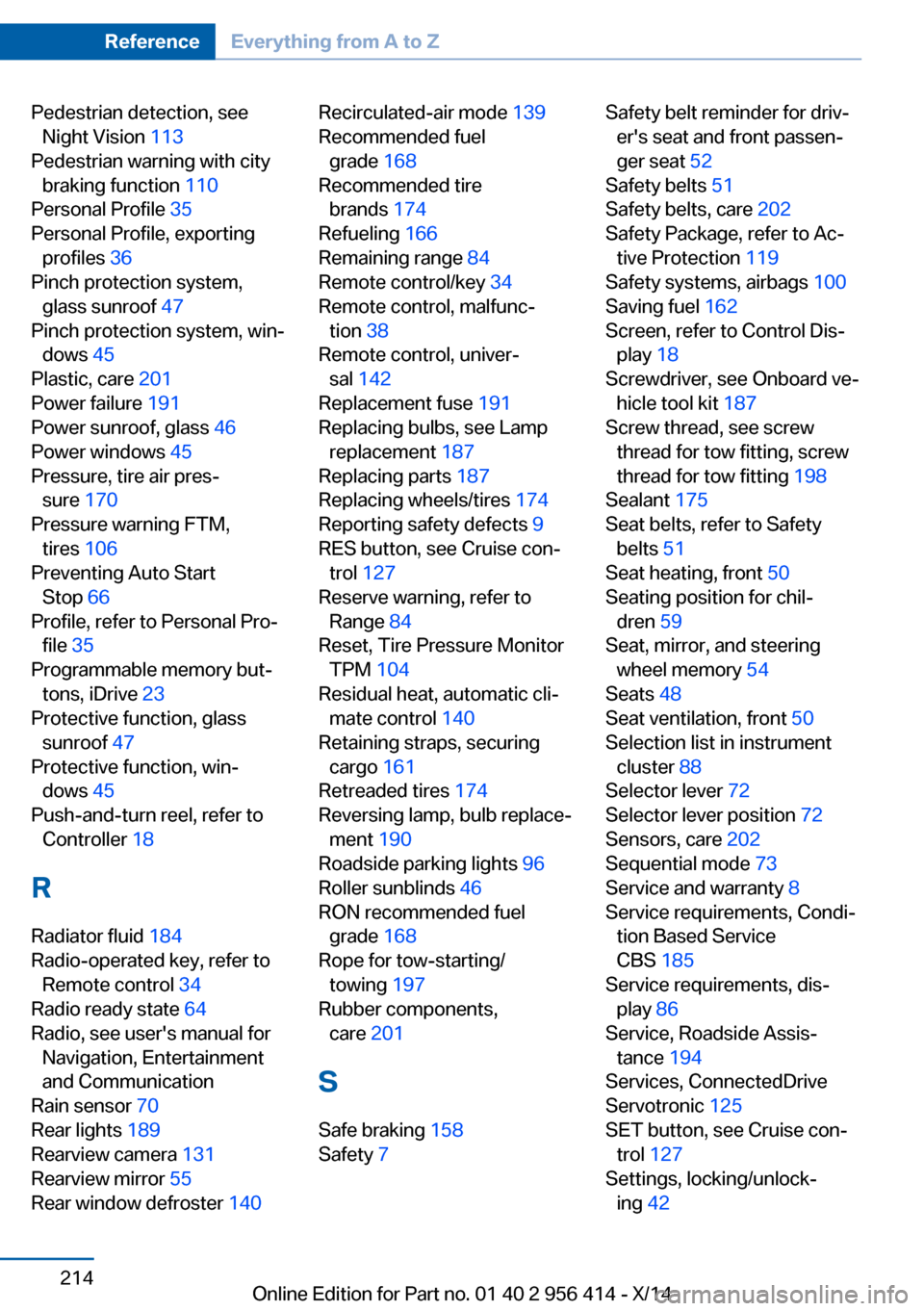
Pedestrian detection, seeNight Vision 113
Pedestrian warning with city braking function 110
Personal Profile 35
Personal Profile, exporting profiles 36
Pinch protection system, glass sunroof 47
Pinch protection system, win‐ dows 45
Plastic, care 201
Power failure 191
Power sunroof, glass 46
Power windows 45
Pressure, tire air pres‐ sure 170
Pressure warning FTM, tires 106
Preventing Auto Start Stop 66
Profile, refer to Personal Pro‐ file 35
Programmable memory but‐ tons, iDrive 23
Protective function, glass sunroof 47
Protective function, win‐ dows 45
Push-and-turn reel, refer to Controller 18
R Radiator fluid 184
Radio-operated key, refer to Remote control 34
Radio ready state 64
Radio, see user's manual for Navigation, Entertainment
and Communication
Rain sensor 70
Rear lights 189
Rearview camera 131
Rearview mirror 55
Rear window defroster 140 Recirculated-air mode 139
Recommended fuel grade 168
Recommended tire brands 174
Refueling 166
Remaining range 84
Remote control/key 34
Remote control, malfunc‐ tion 38
Remote control, univer‐ sal 142
Replacement fuse 191
Replacing bulbs, see Lamp replacement 187
Replacing parts 187
Replacing wheels/tires 174
Reporting safety defects 9
RES button, see Cruise con‐ trol 127
Reserve warning, refer to Range 84
Reset, Tire Pressure Monitor TPM 104
Residual heat, automatic cli‐ mate control 140
Retaining straps, securing cargo 161
Retreaded tires 174
Reversing lamp, bulb replace‐ ment 190
Roadside parking lights 96
Roller sunblinds 46
RON recommended fuel grade 168
Rope for tow-starting/ towing 197
Rubber components, care 201
S Safe braking 158
Safety 7 Safety belt reminder for driv‐
er's seat and front passen‐
ger seat 52
Safety belts 51
Safety belts, care 202
Safety Package, refer to Ac‐ tive Protection 119
Safety systems, airbags 100
Saving fuel 162
Screen, refer to Control Dis‐ play 18
Screwdriver, see Onboard ve‐ hicle tool kit 187
Screw thread, see screw thread for tow fitting, screw
thread for tow fitting 198
Sealant 175
Seat belts, refer to Safety belts 51
Seat heating, front 50
Seating position for chil‐ dren 59
Seat, mirror, and steering wheel memory 54
Seats 48
Seat ventilation, front 50
Selection list in instrument cluster 88
Selector lever 72
Selector lever position 72
Sensors, care 202
Sequential mode 73
Service and warranty 8
Service requirements, Condi‐ tion Based Service
CBS 185
Service requirements, dis‐ play 86
Service, Roadside Assis‐ tance 194
Services, ConnectedDrive
Servotronic 125
SET button, see Cruise con‐ trol 127
Settings, locking/unlock‐ ing 42 Seite 214ReferenceEverything from A to Z214
Online Edition for Part no. 01 40 2 956 414 - X/14